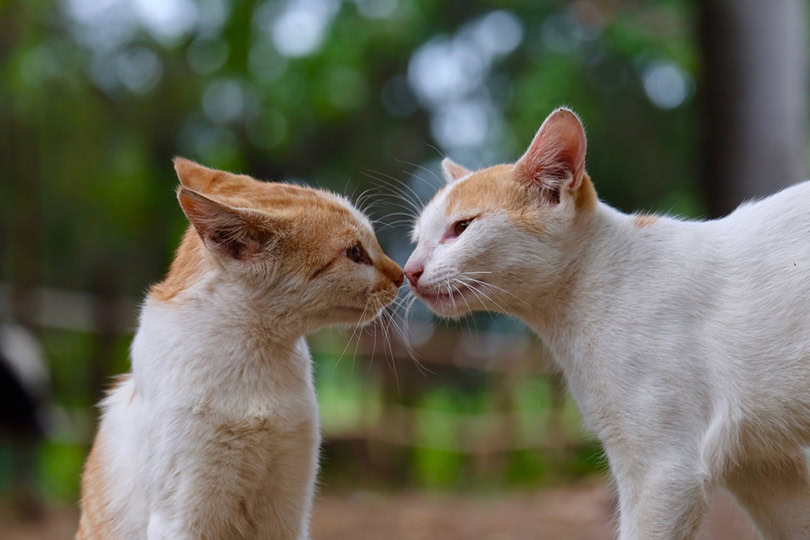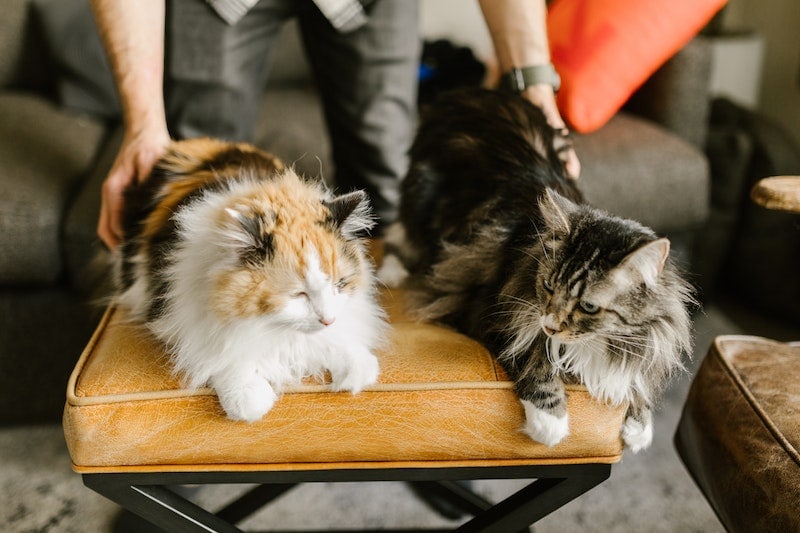VET APPROVED

The information is current and up-to-date in accordance with the latest veterinarian research.
Learn more »Click to Skip Ahead
Two cats can get along in the same house. Domestic cats aren’t strictly territorial and can live with others when properly introduced. Socializing your cat early can help them get along with others. However, even if your cat isn’t well socialized, introducing them slowly and purposefully can help them become friends.
Cats of all genders can get along, including two females. While cats differ in temperament depending on gender, female cats are not particularly aggressive toward each other.

The Importance of Socialization
Socialization is vital if you want your cat to live with others with some degree of success. You want to start socialization early and occasionally continue when your feline is older. There are many benefits to socialization, including:
- Reduces stress and anxiety: Cats that are not socialized may become stressed and anxious in new environments, leading to health problems such as urinary tract infections and gastrointestinal issues.
- Promotes good behavior: Socializing your cat can prevent behavioral problems such as aggression and inappropriate elimination.
- Makes vet visits easier: Socialized cats are more likely to tolerate vet visits and handling, making it easier to keep them healthy and up-to-date on their vaccinations and preventative care.
- Enhances the human-animal bond: Socializing your cat can strengthen the bond between you and your pet, leading to a more fulfilling and enjoyable relationship. Your bond will likely stay strong when your cat is socialized enough to cause fewer problems.
Socializing will help your feline get along with any other cat you adopt in the future. Without socialization, your cat may struggle to get along with others. While unsocialized cats can still get along with each other occasionally, there is far more likely to be a problem than with two socialized cats.

What to Consider Before Adopting Another Cat
If you already have one cat, it’s crucial to determine how well they are socialized and get along with other cats before adopting another one. A well-socialized feline used to other felines is far more likely to get along with other cats. No matter how much experience your feline has with other cats, it can take months for them to warm up to a new cat. Be sure you’re willing to put in this much work before you adopt a cat.
Furthermore, it should be noted that adopting a cat just to keep your other cat company can be hit-and-miss. You never know when two cats are going to get along, and playing feline matchmaker is surprisingly difficult. Therefore, if that’s your only reason for adopting another cat, you may want to think twice.
Cats can be expensive. Two cats mean double the food, vet care, litterboxes, and toys, which also take up more space. You need to get another litterbox since some cats don’t like using the litterbox after another cat. Feeding, playing with, and socializing your new feline also takes up a lot of time—on top of introducing your new cat to your current cat.
How Long Does It Take for Two Female Cats to Get Used to Each Other?
It can take a couple of months to a year for two cats to get used to each other. Many factors are involved, such as the ages and temperaments of each cat. Socialized cats tend to warm up faster, but there is no guarantee.
Introducing the cats properly is key to ensuring they warm up to each other quickly. You don’t just want to bring your new cat home and let them explore on their own. It’s better to introduce the new arrival slowly and gradually. This process allows your felines plenty of time to get used to each other. Providing each cat with food, water, and a litter box is essential to reduce competition and potential conflict.

How to Introduce Two Female Cats
The key to a successful introduction between two cats is to take it slow and gradually allow them to become more comfortable with each other.
- Keep the cats separated in different rooms for a few days to allow them to get used to each other’s scent. Switch out blankets and toys regularly. This process also gives the new cat time to smell like your home, which can reduce conflict with the older cat.
- After a few days, switch their rooms and allow them to explore each other’s living spaces while keeping them separated by a closed door or baby gate. You can switch them back and forth every day to keep each cat’s scent fresh in the area.
- Gradually increase their exposure to each other by allowing supervised visits in a neutral space, such as a hallway or a room with no specific territory. Don’t force the cats together. Instead, open the door and allow each cat to approach and explore as much as they want.
- If there are any signs of aggression or tension, separate the cats and try again later. It’s normal for cats to be aloof toward each other for a while. However, there shouldn’t be any aggression or bullying.

Conclusion
Two female cats can get along in the same house. However, that doesn’t mean that they will. Several factors determine if the cats will get along with each other or not. For instance, some felines just like other cats more than others.
Socialization and a proper introduction are vital to ensuring your cats get along well. If your cat isn’t socialized or the introduction is rushed, the odds of aggression are higher. While there is a common belief that male cats are more social and friendly than females, the truth is that each cat has a unique personality and temperament, regardless of their gender.
With the proper introduction, socialization, and management, two female cats can form close bonds and live together peacefully.
Featured Image Credit: Nils Jacobi, Shutterstock











